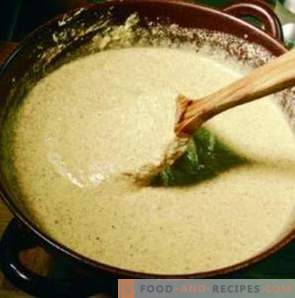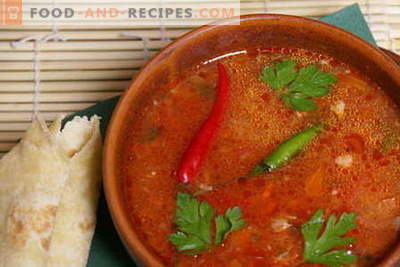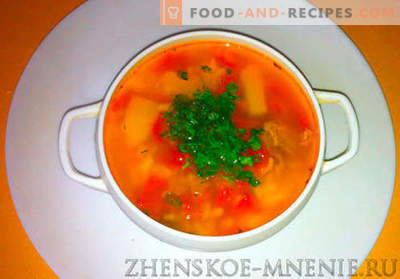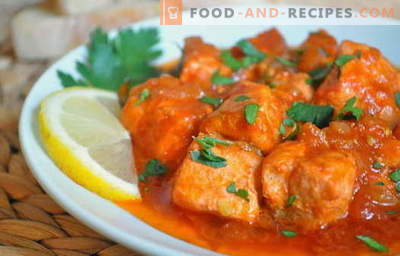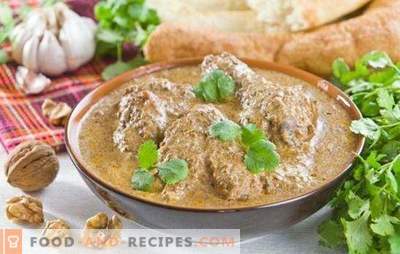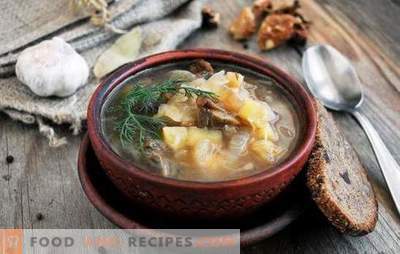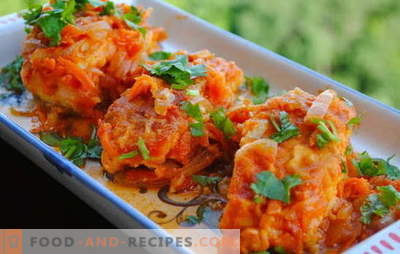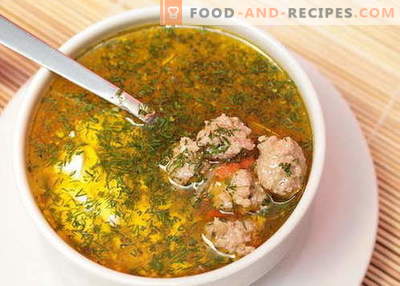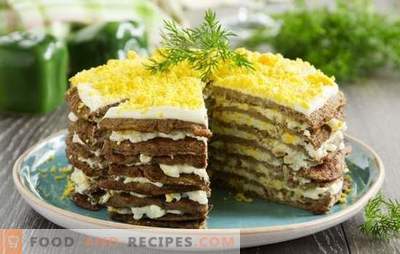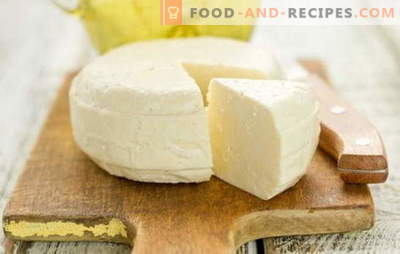
Caucasian cuisine is comparable to simplicity of technology of many nations, but is famous throughout the world. Each dish is a separate story, a unique taste, despite the almost standard set of ingredients, which grow in abundance on the fertile land. There is nothing difficult in preparation, just like in Georgia, they cook in Turkey, Iran, in Russia, but it turns out, anyway, in a special way. No wonder that the national dish, having gained popularity all over the world, acquires some features that are not characteristic of the identical kitchen. But about this - a little later, in the recipes.
Satsivi is not a dish, but a tradition, style, way of life and thoughts of the people. Satsivi has long belonged to the category of cult and international dishes. It is surprising that in cafes and restaurants in Georgia it is prepared very rarely. But beyond its borders, every institution of Caucasian cuisine attracts visitors, including satsivi on the menu without fail, not forgetting to tell that only in this restaurant they know how to properly cook this satsivi. Meanwhile, every woman in Megrelia and Ajara keeps her signature recipe for Satsivi, and it is always prepared for Christmas, but it is prepared differently: in the West of Georgia - more spicy and salty, in the eastern part - more spicy, in the Persian style.
There are other nuances of this dish, but to talk about them is the same as teaching every hostess in Russia to cook soup. No one really knows what the very first recipe of satsivi was, but anyone who, at least once, tried the chicken in a nut-garlic sauce with spicy greens, considers himself a guru of Georgian cuisine. From all this, it follows that one should not be afraid of one’s “incompetence” - everything will work out. When starting cooking satsivi, be sure that no critic himself knows how to cook the dish correctly. Another very weighty argument for courage: there are no two absolutely identical dishes in the world, even if they are prepared by the same cook, from the same products. Cookery is not only science and technology, but also creativity, mood. But some features, nevertheless, are worth considering in order to preserve the national flavor.
Classic Satsivi step by step: basic technological principles
First, the housewives, who do not know how to cook rich chicken broth from poultry meat, must also be found, and this is the basis of satsivi. The broth must be saturated to such an extent that, when cold, it acquires a jelly-like consistency. So, the whole trick is to choose a suitable well-fed carcass, because not a single Georgian housewife adds gelatin to saatsivi broth, as our grandmothers did not do when cooking aspic. But in jelly, you can add other types of meat, for better hardening, but for satsivi this method is not suitable - only chicken or turkey! Geese or ducks in Georgia are rarely cooked, and the habits, mixing different types of meat in a dish, are not there either, because for each meat and in general for each dish there is a special sauce.
You can cook the bird in a small amount of water to get a more rich broth, but for this it will have to be divided into parts and very slowly stew. Then filter the broth, the meat is cooled and laid out in portions of the tureen, with or without bones, to whom, as it is convenient, pour sauce. Some Georgian women fry boiled chicken to remove broth from it, dry the meat. When roasting in butter, the meat acquires additional nutty notes. There is a third way: boiled chicken flesh is returned to the pan and stewed along with the sauce, so that the meat is soaked faster, it becomes more tender and soft.
The sauce is prepared on the basis of broth, thickened with nut paste, with the addition of garlic, cilantro and spices. These are the components of the sauce - a mandatory component of the famous Georgian dish. Also surely a browned onion is included in the satsivi composition, and at the end of the preparation, wine vinegar or pomegranate juice is added. In general, the basis of all Caucasian sauces is spicy and sweet-sour taste. Please note that meat protein is better absorbed with acidic additives. So, the abundance of meat dishes and sauces for them, in Georgian cuisine, is far from coincidence, but a way of life, creating another legend about Caucasian health and longevity. What can be changed and what can not be done to preserve the national feature of Satsivi?
For thickening hot sauce, flour, corn or wheat, egg yolks can be added. Starch is not allowed. The nut paste itself also plays the role of a thickener. Therefore, there should be a lot of nuts: so that the sauce has, as a result, a creamy consistency. Nuts are only walnuts, it is desirable for the kernels to be young, peeled from the brown shell, because the sauce should have a light shade - the lighter the better. Walnuts are a part of many sauces, salads and cold appetizers.
Partially, the sauce is clarified by adding acid, but use light wine vinegar. Pomegranate juice will give the sauce a pinkish hue. This is allowed, but do not overdo it. If neither wine vinegar nor pomegranate juice is available, add lemon juice, apple vinegar - nothing terrible will happen. Nobody believes that “real Satsivi” in Moscow restaurants or coastal cafes on the South Coast of the Crimea is prepared exclusively with these expensive components? Just choose the neutral smell of acidulants and light color. Tomatoes for satsivi can not be used, because it is - is another dish.
Cilantro and garlic are also essential ingredients of satsivi, as is ground coriander, imeretinsky saffron, and suchol. Do not like these spices? There is good news: fresh cilantro and garlic juice, interacting, are transformed into a completely new flavor, more pleasant for those who do not like these spices. In addition, there is no strict norm for the ingredients of this dish: all ingredients are added to taste, but the listed seasonings should be present if the dish is stated as satsivi and not as boiled or stewed chicken in garlic-peanut sauce.
Pepper and salt: how to deal with these spices? There are many myths about the sharpness of Georgian cuisine, but these are just myths. In fact, the spicy leafy greens contain salt, and if someone had to try a salted Georgian dish, then most likely the chef did not know about this subtlety. Therefore, salt carefully. The same advice applies to the addition of hot peppers. Important: the dish is served cold, after insisting, so it is prepared, as a rule, on the eve of the holiday, as well as brawn. Successful experiments!
For those who do not know where to start - a few ideas are offered below in the recipes.
1. Classic Satsivi (step by step) - Megrelian cuisine
There is a version quite justified that Satsivi first came up in this part of Georgia. Therefore, we start with the Megrelian version.
Ingredients:
Chicken or carcass parts (breast, wings, thighs, legs) 2.0 -2.5 kg
Parsley root, onion, bay leaf, spices, water - for broth
Nuts, peeled 700-850 g
Cilantro
Garlic
Red pepper, sharp 1/2 pcs.
Ground coriander, imeretinsky saffron, utskho suneli
Salt
Butter, melted butter 120 g
Onions, onion 1.0 kg (net)
Broth 1.2-1.4 L
Wine vinegar, white
Cooking:
Place the processed carcass in a saucepan, cover with cold water, 5-6 cm above the level of the meat. Bring to a boil, remove the foam, and add whole peeled roots, bay leaf, pepper (peas). Tomit on the lowest fire until ready. Strain the broth, transfer the meat to a prepared baking sheet, brush with butter and hold in a hot oven to lightly dry and brown the surface. On the baking sheet you can also put spices and spicy roots, for example, nutmeg, cloves, 2-3 cloves of garlic.
Then divide the bird into portions. Optionally, you can remove the bones. Spread the meat in the prepared dish.
Pass the finely chopped onion until bitterness is removed in a heated pan, with the addition of melted butter. You can use the usual butter of the highest grade, for a more pronounced taste, but the onions should not be burnt, and it must be monitored, stirring constantly. Put the browned onion in the pan.
Chop nuts, cilantro and garlic into a paste with a blender. Some advocates of authenticity insist that it is necessary to cook pasta in a stone mortar, or to scroll twice through a meat grinder - do as it is convenient. The main thing is the result. Combine the onions, nut paste, add the choi suneli, imeretinsky saffron, and other spices. It is desirable that these spices were ground immediately before cooking. Stir the mass by adding warm chicken broth. Adjust the consistency of the sauce: in finished form, after solidification, it should resemble sour cream, so initially add liquid to the nut mixture slightly more than the norm. Boil the mass to a boil, stirring occasionally. Add vinegar and taste. Hot sauce evenly pour the meat. After cooling, remove the Satsivi in the cold, better - at night.
2. Classic Satsivi (step by step), from young chickens
What to do if you could not get a fat, well-fed carcass to cook a beautiful broth, with amber film? Boil the young chicken, just add more chicken legs to the broth and, at least, a single chicken fat, and butter. After cooking, the legs can be discarded, but they will give the broth richness, increasing the content of the gelling substance. Next - everything, as usual.
Ingredients:
Boiled Chicken Fillet
Bouillon
Ground black pepper and nutmeg
Garlic
Ingredients for the sauce (see recipe number 1)
Chicken Fat - For Passing Onions
Cooking:
Strain the broth, throw away all unnecessary. Put the meat on a plate. In the case when the bird does not have enough fatness, it must be “conjured” over it: rub the chicken pieces with a mixture of nutmeg, pepper and garlic. Fry the pulp in the oven or in a pan, with the addition of butter.
All other stages of cooking are the same as described in the recipe above, with the exception of onion sesame. For a richer chicken flavor, add chicken fat to the meat of young chickens: chop it very finely, melt in a frying pan, and passively chop the onion.
3. Classic turkey satsivi (step by step recipe)
Ingredients:
Broth 1.2 l
Cooked turkey fillet (breast) 1.6 kg
For the sauce, except the standard set (see the first recipe): Ground cloves
Celery (leaves)
Pomegranate (juice and grains)
Cooking:
To make nut paste, add celery leaves or stalks with cilantro. Turkey meat has a more pronounced taste than chicken, and celery is ideally suited to it. Grind 3-4 cloves with coriander, add ground paprika and a little chili. Combine mashed nuts, garlic and herbs with ground spices. Pour broth into the nut mass, dip the breast pieces into the sauce, and put on a moderate heat. Cook until bubbles appear, pour in pomegranate juice to taste, add whole grains for decoration, turn off the stove. Pour into the tureen for filing and leave for eight hours. Serve in the same tureen.
4. Classic Satsivi Step by Step - Express Recipe
In the winter, away from the big supermarkets where you can buy all the necessary ingredients, you also sometimes want to make satsivi, and fresh cilantro in the Russian outback is a rarity. Then cook a festive dish of dried herbs.
Ingredients:
Chicken broth and cooked poultry fillet - according to prescription number 1
For the sauce:
Bow
Chicken fat
Dry white wine
Lemon (juice and zest)
The nuts
Parsley
Cilantro, dried
Hops suneli
Garlic
Wheat flour
Cooking:
Calculate the number of ingredients on their own, according to the number of guests and to taste. Cook the broth and chicken according to the first recipe. Finely chopped onion fry with flour in melted chicken fat. Add dried coriander, hops suneli, and parsley to chopped nuts and garlic. Punch the mixture with a blender to a pasty consistency. Combine with onion and chop again. Add broth to a thick mass, stirring until smooth. Put the meat in a heat-resistant dish that can be put on the festive table, pour the broth and then cook the dish in the oven. Serve, as required by the Georgian custom, chilled, for Christmas dinner.
5. Classic Satsivi in a multicooker
Experts may be outraged, but this way of cooking is not worse, and maybe even better than the traditional way. Modern kitchen appliances in order to make life easier for housewives. True, the broth, however, will have to be prepared in advance.
Ingredients:
For broth:
3-4 chicken backs (not less than 2 kg)
Spicy roots (carrots, parsley, celery)
Bay leaf, black and fragrant pepper
Water 3 l
Breasts, thighs, wings 1.5 kg
For the sauce - the ingredients for the first recipe
Cooking:
Divide the backs in half, place them tightly on the bottom of the pan, bring to a boil. After removing the foam, add roots. Stew until tender. Broth strain and divide in half. In one piece, put the raw, sliced pieces of bird. The broth should lightly cover the meat. Bring to a boil again, remove the foam.
Grind all sauce ingredients to a paste, including onions. Add warm broth (second part), spices. Pour the sauce into the slow cooker, to the meat. Set the extinguishing mode to 20 minutes. After adding vinegar or other acidic dressing, salt.
Arrange the chicken and sauce in a la carte plates. Insist, according to technology, then decorate with greens, before serving.
6. Satsivi classic: Georgian dish in Russian
In Russian cuisine it has long been verified that any dish cooked in the oven preserves vitamins and flavor better. Why not try Russian technology combined with the flavors of Georgian cuisine? You will not regret! Consider this a fantasy of a Russian chef in love with Georgian cuisine.
Ingredients: same as in previous recipe
Cooking Method:
Lay chicken breast, drumsticks, thighs, and wings in ceramic pots, raw.
Mix browned onions with chopped nuts, garlic and greens. Add broth to the blender, and punch the mass to a uniform consistency. Spread the prepared sauce into the pots, covering the meat with it. Cover with lids. Put the pots in a deep pan, add water so that the sauce does not burn. Stew satsivi in sealed pots for half an hour, at 200 ° C. Leave in the oven until cool, then transfer to cold. Then put in each pot to decorate several grains of pomegranate, a slice of lemon and a sprig of greens, before serving.
Classic Satsivi: Secrets
To easily chop the nuts into a paste, dry them.
Try to remove the film covering the core, because it gives bitterness.
In order not to spoil the blender (which is the fastest and most convenient way to make nut paste!), Add a bit of refined vegetable oil with a neutral taste to the nuts.
Juice of leafy greens will also help chop nuts: it will not allow the nut mass to stick to blender knives.
